Ski gear – What’s new for 2024?
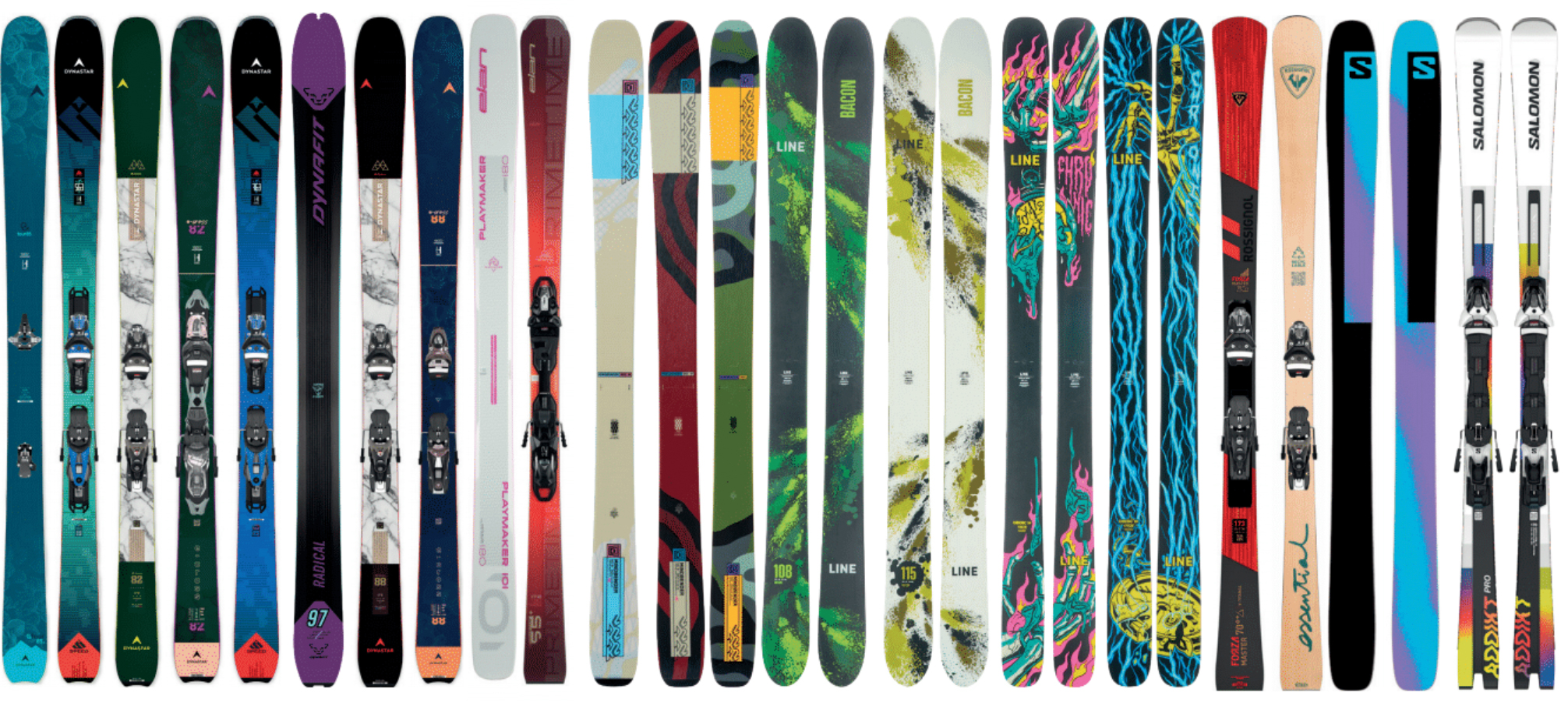

A word from Fall Line Gear Editor Al Morgan about what’s new in ski gear for Winter 2023-2024.
The hot topic, even if that is an unfortunate phrase, is climate change and the sustainability subject. This is an area of key focus, with brands racing to find solutions that help reduce the impact on the environment and innovate with new technologies and processes.
We’ve already seen big developments in clothing and soft goods, so we wanted to focus a little more on hardware, as there’s been significant improvements in how manufacturers are working. Don’t worry though, we’ve still got some juicy bits of other kit to tell you about…
While writing this, for the first time ever, there was a multinational meeting of around 80 ski and outdoor brands looking at just how to work more sustainably. Organised by Atomic, FESI (Federation of European Sporting Goods Industry) and POW (Protect Our Winters), it involved a lot of the big dawgs of the ski industry, including Salomon, Scarpa, the Tecnica Group (Nordica, Tecnica, Blizzard), Dalbello, Rossignol and many more. It is fantastic that brands are finally coming together in this manner to find solutions to the challenges sustainability highlights.
Brands have been working to reduce their environmental impact for quite some time, with many analysing everything they can, such as concept and design, materials sourcing, manufacturing, wastage, shipment, use and what happens at the end of a product’s life. It can take years just to gather the relevant information, but we’re starting to see a real shift in how brands approach what they do. What’s refreshingly surprising, when testing, is just how well this new breed of kit performs.
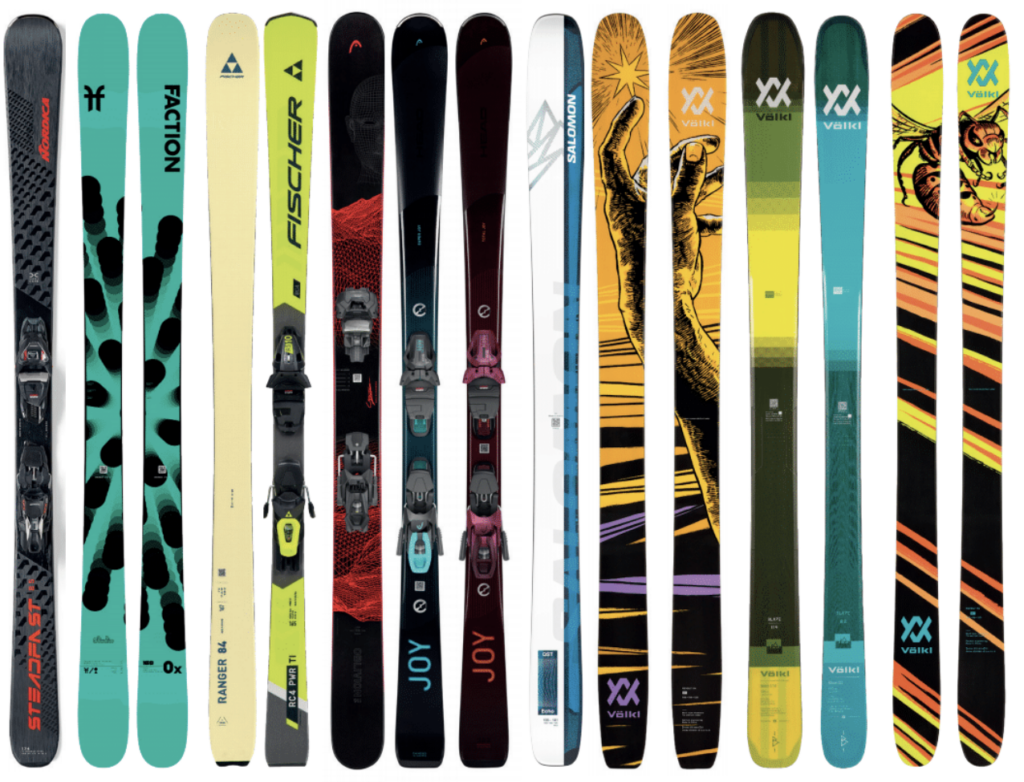
A great example is the Rossignol Essential ski, in development for a whopping 10 years. While this was available in limited locations for some of last season, it’s essentially (‘scuse the pun) a new product for most of us this winter. Looking a bit like it’s made of raw wood, it uses recycled and bio-sourced materials and is more than 75% recyclable. It’s so different, you wonder if this can perform anything like its regular siblings. Well, it can; this ski is phenomenal and can hold its own with the performance piste skiing brigade (also watch out for the new Rossignol Forza piste skis, although they don’t boast the same credentials).
Salomon‘s been using life-cycle assessment (LCA) to get a clearer understanding of how they can significantly reduce the carbon footprint of their products. A lot of these learnings will come to the fore in the coming seasons, but the new QST Echo has recycled materials in the top sheet and sidewalls. Think of this as a lighter version of the QST 106; a great option if you’re happy to skin for your next powder lap. There are also a couple of new piste skis, called Addikt, and the top-level Addikt Pro has vibrant, multi-coloured sidewalls using recycled ABS plastic. It may look cool, but this ski has so much more going on and blew us away when we tested it.
Dynastar‘s taken a similar approach, introducing their Hybrid Core 2.0. The wood laminates have fibres orientated in more directions, helping reduce the amount of fibre glass needed. They’re also working the wood in different ways to lessen the environmental impact. This tech is available in the all-mountain piste-focussed 4X4 line, in the 563 and 763 models, along with the new M- and E-Cross 82 and 88 models for all-mountain skiers wanting something less piste orientated. Ski tourers also get HC 2.0 love, in the M-Tour 108 F-team, M-Tour 85 and E-Tour 85.
Atomic also used LCA, focusing on their Backland touring skis. It’s taken a couple of years to do this analysis, but the new skis use less glass and metal, and replaces some virgin materials with recycled alternatives. They’ve also added an 88, alongside the 85 and 95 widths. With this design, they’ve been able to reduce CO2 emissions by as much as 30% and improve the skiing performance. The Backlands were popular, but we think the new puppies are a significant improvement.
Dynafit has a couple of new models, in the Radical 97 and 107. The 97 is available as a full-rig set, including the ST Rotation 10 binding and a set of skins for £1,350, for women and men. If 107 isn’t big enough, you should check out their new Tigard 114. Like the Radicals, this ski’s built for the descent, pairing with the new Tigard 130 boot (keep reading for more on that).
Sustainability’s a core component of Elan‘s operations, manufacturing in one location, in Europe, sourcing over two thirds of the materials from within 250 miles of the factory. They’ve a new family of piste skis, called Primetime. The widest performance ski in the line is the 55+ and it’s great, but the real surprise was the bottom-end 33; we didn’t quite expect it to ski how it did. The women’s models share the same construction, but have a different binding system, naming and colourway, and are only available in the shorter lengths. The Playmaker 101, for a little freestyle freeride, and 91, for all-mountain fun, are their two new freestyle models.
Armada turns 20 this season, and they’re focussing on their core ARV and ARW skis. A new injection-moulded TPU sidewall increases durability by around 50%. This w3Dgewall appears on the completely new 88, 94 and 100 widths. They’ve added an ash wood binding insert, increasing binding retention strength and sustainability credentials, changed the shapes and reduced the weight; the ARW 100 in 172cm is 100g lighter than last season’s 170cm ARW 96.
From this season, K2 is using Wend eco waxes in the factory for all skis and snowboards. The Mindbender carbons are made with bio resin and have updated shapes and profiles. K2’s done quite a lot with some of the Wayback skis too, changing shapes, increasing the rocker profile, and updating the construction of the 89, 98 and 106 models.
Sister company Line‘s gone with bio resin in their new Chronic and Bacons skis as well. Fancy a rasher? Choose from the full-fat 115 Bacon for some powder freestyle, or the leaner Bacon 108 for greater versatility. They’ve removed the scooped spoon-tech and beefed up the sidewall. Chronics are the narrower partners, with a totally new 101, along with a 94 replacing last season’s 95. They benefit from thicker sidewalls and the top sheet’s bonded to the steel edge at the tip, improving durability.
Scott‘s new touring-orientated Pure Tour 100 and Pure Tour 90 W use natural flax fibres, combined with recycled and virgin materials. They’re stating these are your One Ski Quiver. It must be true, as they’ve used capitals. Jokes aside, they are pretty awesome. They’ve also got a new all-mountain Pure AM 92 Ti, sitting between the Pure Free 90 Ti and the Pure Mission 98 Ti. It has more power than the Free, with a similarly sized waist, although the shaping is freeride inspired.
Nordica Double Core has been added to the Dobermann, Spitfire and Steadfast ranges. There are quite a few models to choose from, but the Spitfire 74 DC and Steadfast 85 DC are ideal for a broad range of skiers. Dual Core sees elastomer, or elastomer and metal, as the filling in the wood core sandwich, delivering the power Nordica’s known for but in an easier to handle package.
The new Fischer RC4 Power Ti delivers sensational on-piste performance for a palatable £600, including a binding. They’re also bringing out a narrower Ranger 84, to add to their wider Ranger freeride collection.
The Rustler and Sheeva names aren’t new for Blizzard, but the construction of these freeride beauties is, and it’s the same for the women’s and men’s models, just with a change in graphic. They’ve placed a titanal frame under the binding and over the edges towards the tip and tail, called Flux Form. This is paired with the epic True Blend wood core, utilising different densities of wood in specific areas of the ski to give the characteristic they want, and they’re sensational.
Faction has been focussed on the planet for a long time, gaining B Corp certification in 2022. They’ve a new 117-underfoot La Machine, called the Massive, which sits between the 109 La Machine Mega and the 126 La Machine Max. Their new Studio line is dedicated to park and pipe skiers, with a fully symmetrical shape, no rocker and loads of camber. The 83mm 0 and 0X are your pipe weapons, while the wider 90mm 1 and 1X are aimed at park and slopestyle rippers.
Black Crows has tweaked their Nocta freeride ski, adding a little camber underfoot. They’ve also got a completely new ski in their touring range, called the Draco Freebird (110 or 112mm underfoot, depending on size). This is a twin-tip touring ski, so you can skin up, ski down and get inverted.
We’re also fans of the Völkl Blaze range of lighter weight freeride skis, and they’ve got a couple of new widths for this winter. There’s a new narrower 82, as well as a new 114 fatty. The brand’s also bringing out a 114 Revolt, although this is a bit more directional than its siblings, with a flatter tail. It’s ideal if you’re charging big spines down steep Alaskan faces, and let’s face it, who isn’t (well us, that’s for sure). There’s a new Revolt 96 too.
Head‘s been doing a lot with their women’s range, after bringing in a new boss for the women’s line. They’ve changed the front shape of the Joy skis, played with the profiles, and tweaked the binding plate. On the upper-end models, the Total, Super and Power Joy’s, they’ve also introduced Head’s superb Protector binding, still with the same increased protection against knee ligament damage, but in a design better suited to female skiers. The Joy skis also now get Energy Management Circuit across the whole range. Freestyle skiers are also getting some love from Head, thanks to the new Oblivion 102 and 116 backcountry freestyle models.
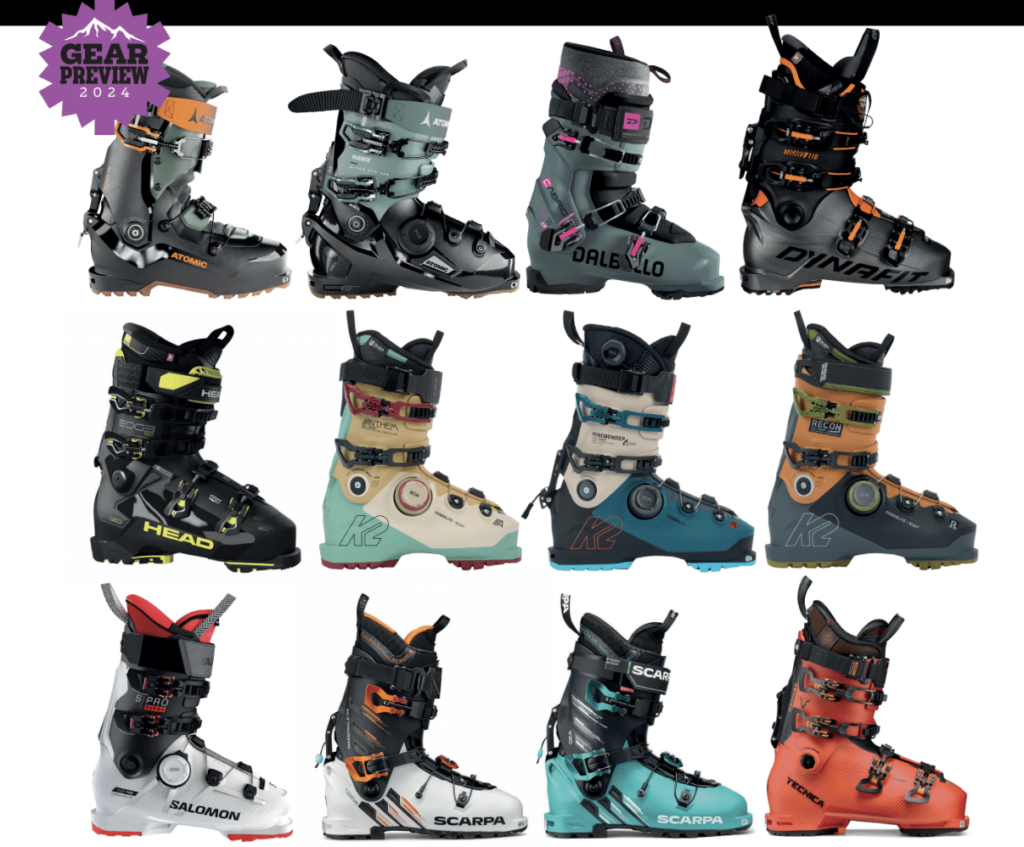
Even though we’ve been talking quite a bit about sustainability, BOA is the big talking point for boots. Yes, BOA has been available on many ski touring boots for years, but not for alpine skiing. BOA has spent a lot of time (and money) developing the new H+i1 dial and cable. The system is incredibly robust, beautifully wrapping the shell around your foot, without undue pressure hot spots some experience using a traditional buckle closure. There is a ‘but’ though; not all brands are offering this system for this winter, only Fischer, K2, Salomon and Atomic, and it adds around £90 onto the price of a boot.
For Salomon, their BOA boot is called the S/Pro Supra, available in 95 to 130 flexes, using an all-new shell and liner. You still get full-shell heat customisation, and this medium fit Alpine boot has a lovely smooth flex. The new liner has ExoWrap, a broad elasticated band around the instep. It sounds basic but the way this holds your foot, working in harmony with the BOA, really surprises. We skied this in the men’s and women’s versions, and you can find out how we got on next month’s Gear Guide.
Fischer has also focussed on the downhill market, adding BOA to their range of medium volume RC4 boots, to take advantage of the excellent foot wrapping you get with the BOA H+i1 system. The 140 flex RC4 Pro BOA comes with a Zip Fit liner, giving incredible hold. The softer flexes get regular liners but have the benefit of Fischer’s Vacuum fit customisation.
K2 has jumped in with both feet, offering BOA on Alpine and Freeride boots, which are also available in four-buckle versions. It’s worth noting that the shell must be designed especially for the BOA system, it’s not simply a case of taking off the buckles and bolting a dial and cable on. The piste-oriented Anthem and Recon BOA boots range from 95 flex through to 130. BOA’s also available on their Mindbender freeride boots, from 95 up to 130, with the top-end flex for women and men also having BOA on the liner. They classify the BOA boots as MultiFit last, working for 97 to 100mm, for narrow and medium foot volumes. Given how the BOA works, this is a pretty good way to think about the H+i1, as it really helps to pull the whole fit in around the foot.
Atomic is only including BOA on their lower volume Hawx Ultra XTD freeride boots. They also offer these models in a four-buckle version too. Available in two flexes for women and two for men, the new design has allowed Atomic to change to PU construction, for improved skiing and durability over the polyamides used previously. Leaving BOA aside and heading further off-piste, Atomic has a new medium last freetour boot, called the Backland XTD, sitting between the Hawx XTD freeride and narrow Backland touring boots. They’ve tinkered with pivot placement with amazing effect, and the resulting freedom of movement when touring is crazy.
The new Lange Shadow boot, while not for touring, is something very different and doesn’t have BOA. It’s a super interesting design, with unique features, allowing you to play with the suspension of the boot, a bit like you do with mountain bikes. Think of it like being able to tinker with sag, compression and rebound, tailoring the feeling you want when skiing, and you certainly notice the difference. They’ve also done a ton of work with the liner; they’re great to ski in.
Nordica has brought out an Unlimited freetour/freeride boot line, designed so it can be deconstructed, making it easier to recycle. It comes in 95, 105, 120 and 130 flexes, with a 65° of cuff mobility in tour mode and pin inserts, to compliment the screwed-on Grip Walk sole. They also offer the lighter Unlimited 115 LT and 130 LT, if you’re counting the grams but still want to charge hard.
Tecnica‘s one of the brands at the fore of ski boot sustainability, recycling 6,000 boots last year. The popular Cochise freeride boots now utilise recycled materials, and they’ve added a wider 102mm last alongside the narrower 99mm version. If you’re more about firm snow, the women’s Mach1 Pro is being replaced by the Mach1 115, offered in a medium and low volume version, and the 105 flex also gets a high volume 105 flex option.
The high-volume Edge boot from Head has been redesigned, making it a breeze to put on, it’s easier to walk about resort, skis better and is very comfy. While not a new product, Head’s also adopted the more popular volume initialisms for low (LV), medium (MV) and high volume (HV), dropping the RS label.
Rossignol‘s also gone down the LV, MH and HV route, along with HV+, while adding more Alltrack LT boots to their range, for an easier time ascending.
Italian boot maestro Dalbello has a new line of 99mm last boots, called Cabrio. The standard Cabrio LV, in 85 through to 130 flexes, replaces the iconic Kryton, with the Lupo stepping aside for the Cabrio LV Free boots. This LV Free version, available in a women’s 105 flex and men’s 120 and 130, is the one for charging freeride skier with a desire to skin for freshies.
For this season, Dynafit’s added the TLT X Extra Wide. It’s a whopping 107mm last, 6mm wider than the regular TLT X and a great solution if you struggle to find touring boots with enough volume. Of greater interest for most people is Dynafit’s new Tigard boot. (Think a blend of tiger and leopard). It has the superb Hoji lock system, comes with a Grip Walk sole and pin inserts, so competes directly with a lot of the freeride boots out there. The Tigard is a 101mm last boot, available in a 130 and 110 flex, and there’s a whole range of Tigard clothing.
The Scarpa Maestrale and Gea have been a go-to touring boots for the masses, and they’ve had a lot of design updates for this season. They’ve worked on the shape and construction, enhancing the shell with carbon, improving the skiing yet keeping the weight down. The shell’s 1mm wider, at 102mm. The stiffer RS versions have received the same improvements, but also have a carbon injected cuff and we were impressed with the power they delivered.
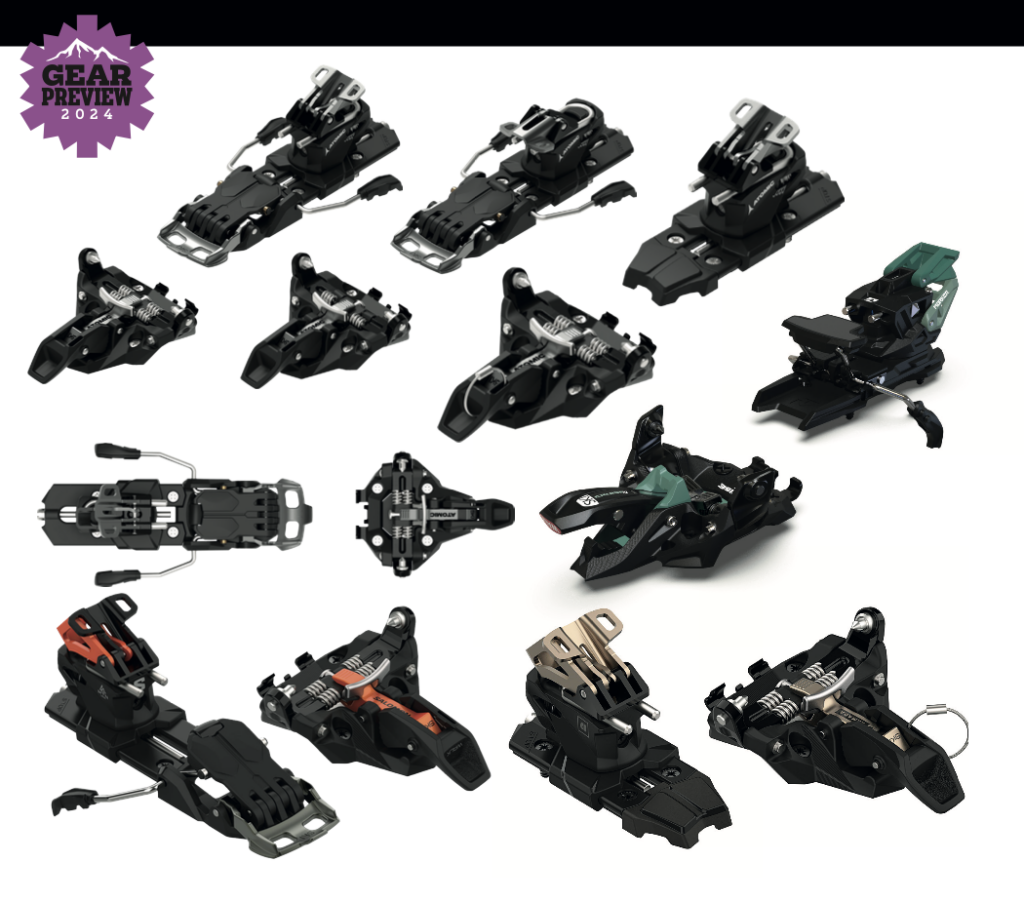
Although it’s mostly tweaks in the binding world, there are a couple of touring bindings coming out.
The Cruise pin touring binding from Marker has sustainability as a key development goal, using recycled and bio-based plastics, as well as being the first to use biodegradable lubricants, resulting in a CO2 saving of over 60%. It’s a totally new design, with adjustable vertical and lateral release in the heel, a toe bumper to guide the boot in and an easier step-in system than the Alpinist (30% easier, they say). There’s a lot more going on, and we’ll cover that in the next issue.
Atomic, and Salomon sit under the Amer Sports umbrella. Although, for the most part, they operate quite separately, the one key area they come together is in binding development. They’ve got new pin touring bindings, called Summit, which use composites and metal, so are cheaper. They’re similar weights to their existing pin bindings, have more travel in the heel piece, and you can adjust the lateral release value. Select from a release value up to 12, 9 or 5, all with brakes, or go leashless with the 12 and 9. Armada, also part of Amer, offers the Summit 9 with a brake.
This may sound like an interesting new product but, as we were going to print, Amer issued a voluntary and precautionary product recall for a specific production run of their pin touring bindings, manufactured between 1 May 2022 and 31 March 2023. Visit your retailer if you’ve any concerns, or visit Salomon or Armada Skis for more information.
We’re big fans of brands holding their hands up if something isn’t up to their high standards, especially where safety’s concerned. It’s tough for them and customers, but as the saying goes ‘better safe than sorry’.
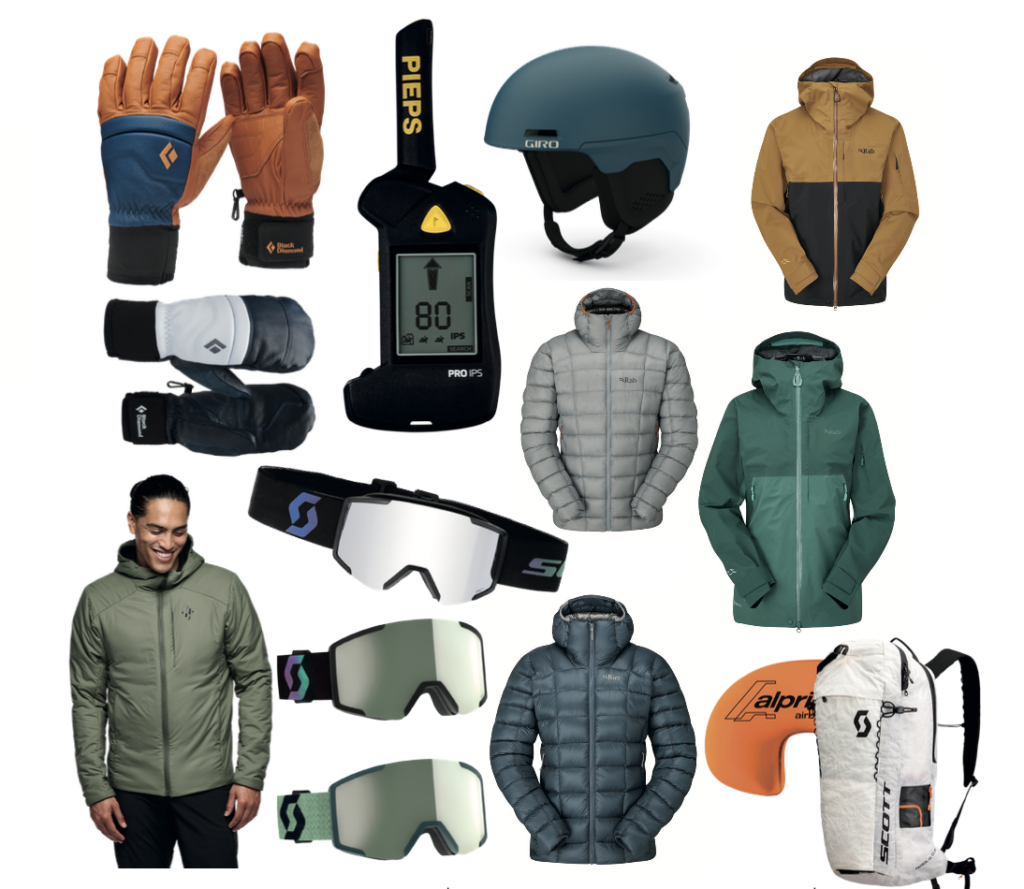
Following the success of the new Impulse glove last winter, Black Diamond has re-worked the Spark, and you can find out more about the new gloves and mitts in the next issue of Fall Line, the jam-packed Gear Guide. We’ll also be talking about Black Diamond outerwear, but the juicy new piece is an insulated mid, called the First Light Stretch hoody. It’s like being hugged by a dream; it’s so light yet gives surprising warmth and an amazingly free movement.
British outdoor equipment specialists, Rab, has a new down jacket, the Mythic G, offering their best warmth-to-weight ratio yet; it’s incredibly light and cosy. They’ve also got new Khroma ski wear pieces, again bringing in more recycled fabrics, and we’ll be talking with Rab in the Gear Guide issue about how they’re helping inform consumers, though their Material Facts initiative.
The Ted Ligety brand, Shred, has been working on how to be more sustainable for a while, and was one of, if not the, first goggle brand to remove plastic packaging from the goggles. They’ve released a new frameless goggle, called Gratify, bringing a frameless cylindrical design to the Shred stable. It’s available with the fabulous Contrast Boosting Lens tech, making for happy eyes when shredding the gnar.
Impressing us with their MIPS Spherical system last season, Giro has now slimmed things down with the new Owen. This looks better, is insanely comfortable and has a unique temperature adjuster that sits inside the helmet.
Along with renaming Amplifier tech as Amp, Scott has brought out a new Amp Pro version, made of around 50% recycled resources. It enhances green light whilst reducing blue light, for less eye fatigue, and details are boosted, even in low light. The green tint may sound a little odd but is lovely to use when skiing. Scott’s also released a new Alpride E2 airbag, called the Patrol Ultralight E2 25. It’s very light, coming in at a svelte 1,920g, with the inflator installed.
Pieps, an innovator in the world of avalanche safety, has been working on a new transceiver for some time; the Pieps Pro IPS. We’ve seen a few iterations of this in recent seasons and it’s exciting to see it hitting the stores, although initially it will only be in limited numbers and locations globally. To solve the significant issue of electronic interference, they’ve come up with an Interference Protection System, to compensate for this ‘noise’. They’ve also designed the Pro IPS to simultaneously search on two antennae, and it boasts an 80m search width. These new systems will really help when the hoo-ha hits the fan. Although it hasn’t had a price confirmed yet, we imagine it will be towards the upper end.
For a deeper dive into 2024 gear, get yourself a copy of the Fall Line Gear Guide, bringing you all the latest innovations, tech and gear on the market. Click the cover to order a copy for £5.50